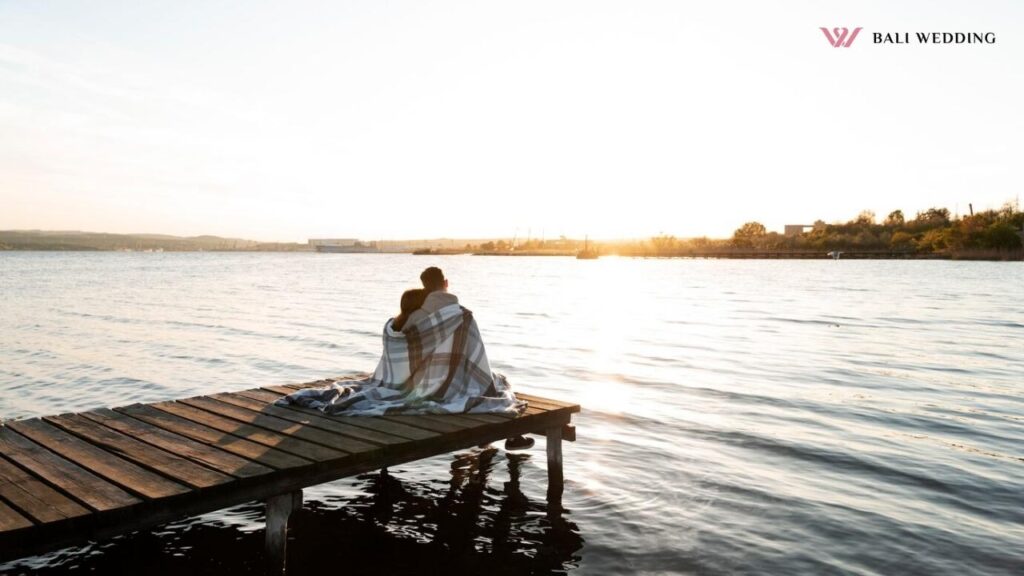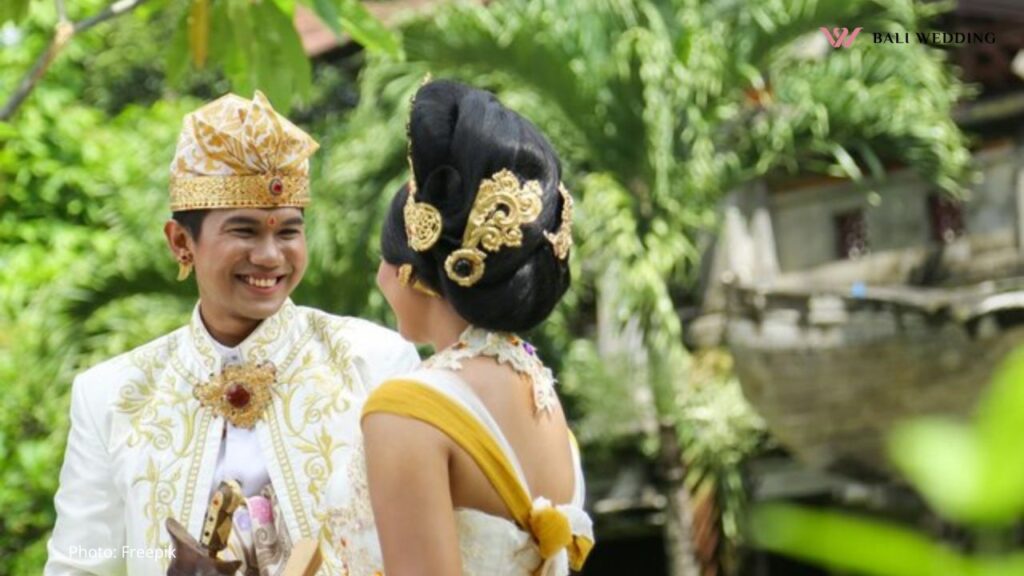June 10, 2021 • 11min read
Everything You Need to Know About Traditional Balinese Wedding
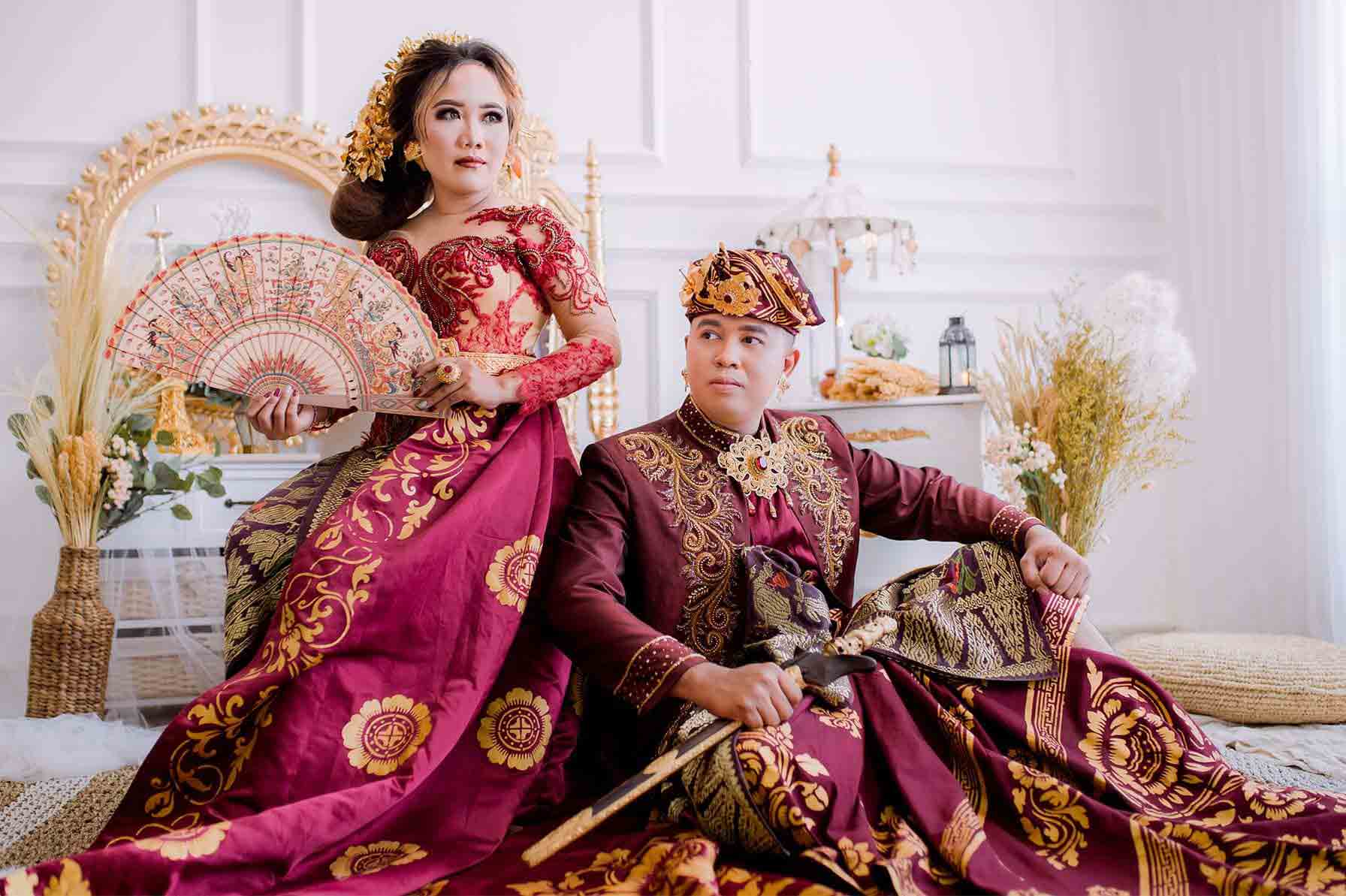
A wedding is one of the Balinese cultures’ most meaningful events and is always heavily prepared in Balinese society. It is one of the Balinese sacred “yadnya” rituals performed to maintain harmony between the material and spiritual worlds. A Balinese wedding or known as “pawiwahan” is a sacred ceremony as it involves the gods, creatures from the underworld and people as the three crucial witnesses.
A wedding is also the bridge for both bride and groom to become full members of the rural community and banjar, receiving all the rights and responsibilities of their local community. After marriage, the man is officially a full member of the banjar and has been given the right to vote and must take over the duties of preparing and attending their local ceremonies and other community services in the area. Other members of the community also finally recognize and treat him as an adult member.
Without a proper Balinese sacral ceremony, the wedding will not be accepted by the community. And if any violation occurs, the couple may even be exiled from the community village and banjar.
A wedding is a special event as the future generation will continue the Balinese traditions and way of life and can reincarnate what the ancestors have left behind. It is more than just a woman and men coming together. It’s an important spiritual event for every Balinese individual.
The order of the wedding ceremony and rituals is determined by the priest, the location, time and circumstances.
Need a Professional Wedding Planner?
"(Required)" indicates required fields
"(Required)" indicates required fields
Below are the different types of Balinese weddings depending on the proposal:
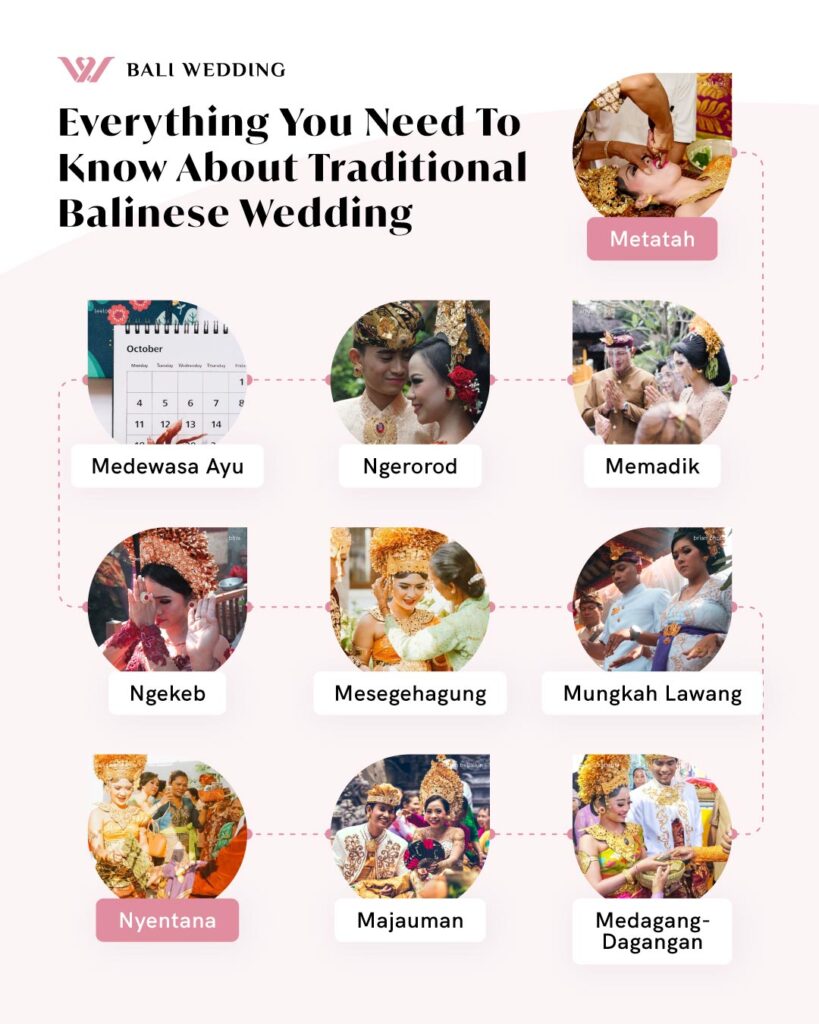
Metatah or Mepandes
This ceremony is a kind of tooth filing ceremony ritual essential for every Balinese and must be done before getting married. The ceremony usually takes place in a series of weddings if it has not been performed before entering maturity.
The ritual consists of prayers and offerings to the gods and is followed by the couple lying down on a low platform surrounded by parents and relatives. Traditional dentists or sangging files canines are also there as the Balinese believe that canines represent the animal characteristics.
The teeth filing process usually takes 10 to 15 minutes. The sangging places a piece of cane sugar in the mouth to prevent the person from closing their mouth. The upper teeth get the filing first, followed by the lower teeth.
This process is believed in relieving the six destructive passions: anger “kroda”, greed “lobha”, anxiety “moha”, envy “matsarya”, vanity “mada” and lust “kama.”
Memadik
The groom’s family visits the bride’s house to inform her family that he wants to get married. The bride confirms and agrees that she is ready to marry him and the whole family agrees to the union—which is a kind of respectful ceremony.
This can turn into an expensive process as it involves offerings and processions. This shows the status of the groom and gains respect from the bride’s family. However, it can also be risky for the groom to gain approval from the bride’s parents first.
Ngerorod
This is when the future bride and groom meet privately, without any interference from their parents. This is usually done in a friend’s place, where they spend the whole night discussing essential details, and when morning comes, they spread information about the future event.
During these circumstances, the girl cannot go back to her parents’ house and continue living the way she did.
Medewasa Ayu
The madewasa ayu event occurs after the bride’s parents agree that their child will marry the man she loves. This process consists of determining a good day for the wedding ceremony.
Choosing the right day is important as it’s believed to be the way to have a blessed, smooth, and prosperous marriage. The groom usually determines a “good” date based on advice from a priest or anyone familiar with nakabang padewaan (a good date for weddings and ceremonies).
Ngekeb
This ceremony is purposed to prepare the future bride for her new life as a wife and housewife within her new family. It starts with a request to God for happiness and good fortune. The bride must first wash her hair to perform this particular ritual.
The bride who is making the offerings must stay in the room until the groom comes and picks her up. The bride usually wears yellow clothes when the groom comes and picks her up. This ceremony symbolizes that the bride is ready to leave her past and is prepared to start a new life with her partner.
Mesegehagung
The Mesegehagung ceremony is a ritual that welcomes the bride to the groom’s residence. It takes place in the groom’s house, involving both the bride and groom. This ritual is a process of inviting the bride where both of them are taken down to the stretcher and prepared to carry out the ceremony.
She first enters a wedding tent and the groom’s mom asks her for a yellow cloth. The groom’s mother then removes the yellow cloth worn by the bride and exchanges it for silver “kepeng” coins worth two hundred kepengs.
Mungkah Lawang
This ritual translates to “opening the door.” The mungkah lawang ceremony is carried out by the groom to pick up the bride and bring them together to undergo nine series of ceremonies. These include pejati, suci alit, peras pengambean, caru ayam, brumbun asoroh, prayascita, bayekawonan, pangluapan, segehan panca warna, segehan seliwang standing and segehan agung.
Before performing these sacred rituals, the groom recites some Vedic mantra which is replied to by the bride and ends with both of them throwing symbolic leaves to repel evil forces that might come during the procession.
In Balinese wedding customs, this ceremony is also a form of respect for the bride’s family and blessings in the hope for the couple to have a harmonious life after marriage.
Medagang-Dagangan
The next ceremony is medagang-dagangan or also known as “selling” in the traditional Balinese language. In this process, both bride and groom are asked to bargain for the offerings until they come to an agreement.
The bride offers her wares to the groom. And once the transaction is complete, the groom tears a special cloth held by the bride with a Keris. Then, both of them take three “tools of fertility” that will be planted in their family temples.
The bride and groom then cut a thread that’s tied on two branches of a dap dap tree and take a shower to clean themselves. This ceremony aims to request Sang Hyang Widhi that the couple’s offspring will bring peace and harmony to the family.
Majauman
Majauman is the form of the official visit to the bride’s house after all the ceremonies are completed. Based on the name, the word “jaum” which means needle implies the function of a needle used to knot and reunite the two families after all the efforts in the ceremony.
This ceremony may also occur during “ngerorod” marriage due to the differences in the woman’s family caste level. Therefore, the bride needs to be “kidnapped” to the groom’s house and get married.
Majauman also aims to inform their ancestors about the marriage and ask for protection and their blessings to avoid distress.
Nyentana
This special ceremony is when a man will join the wife’s family and move into her house. This is usually when the girl’s parents have no sons and therefore have no one to look after their property.
This is why the groom must join the bride’s family and continue the family’s male line. In this case, the groom’s parents must offer consent for this marriage.
Traditional Balinese Wedding Clothes
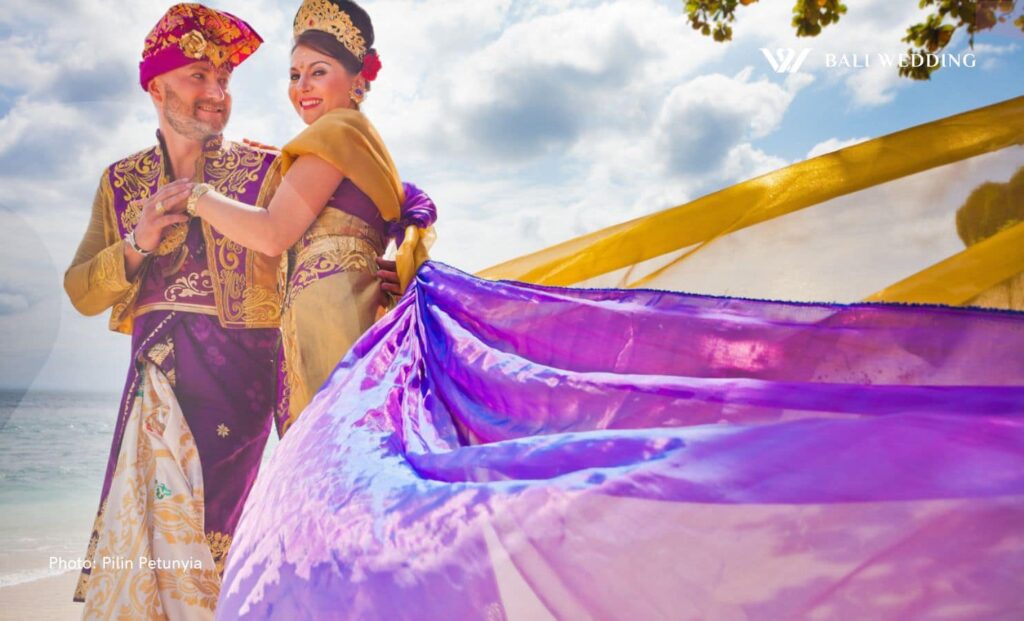
The Balinese wedding clothes are not entirely up to the newlywed’s own choice. The clothes are determined according to their caste. The basis of the canvas is the luxury “songket” which is lavishly decorated with gold and bright colors such as yellow, blue, red and orange, which symbolizes joy.
The luxury of the songket symbolizes the wealth of the family and their caste level. The bride wears a tall crown which also symbolizes her caste, where the taller the crown, the higher her caste level.
After all the wedding ceremonies, the wife eventually inherits the husband’s caste. A rule for a Balinese is that a higher caste usually also looks for an equal caste partner to continue the caste line. If you want to know about it, find out more about the process of a Balinese wedding here.
That is very much everything you need to know about the terms of a Balinese wedding. Have you ever attended a traditional Balinese wedding? Which ceremony do you think is the most interesting? If you are interested in having a wedding in Bali, explore Bali Wedding Prices and share your own experience of your special day in Bali!
Related Articles
Intimate Bali Wedding Ideas: Perfect Small Ceremony Guide
Complete Bali Wedding Packages: What’s Included and How to Choose
Have to decide how your dream wedding will look like?
Lorem ipsum dolor sit amet, consetetur sadipscing elitr.


